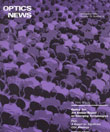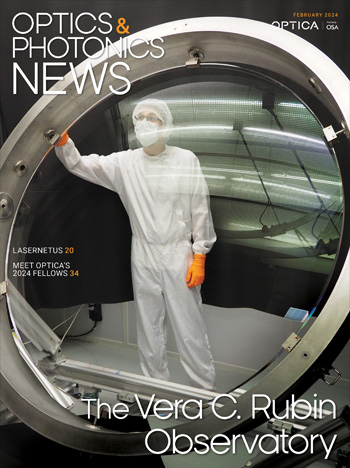
November, 1984 Issue
- Quantum Well Optical Modulators and Seed All-Optical Switches
- The Soliton Laser
- Porous Silica Antireflection Coatings
- Inner-Shell Photoionization Lasers
- Compression of Laser Pulses
- Mirror-Forming Technology for Integrated Diode Lasers
- A Laser Roto-Rooter
- Tropospheric Remote Sensing
- Browse all Issues
Feature Articles
Quantum Well Optical Modulators and Seed All-Optical Switches
When thin (e.g., 100 Å ) layers of the semiconductors GaAs and GaA1As are grown alternately one on top of the other, many interesting physical effects result. One is a new electro-absorption mechanism which can be used for high-speed optical modulators or low-energy all-optical switches compatible with laser diodes.
by D.A.B. Miller, T.H. WoodThe Soliton Laser
The soliton laser represents a brand new principle for the production of ultrashort light pulses. Pulse compression and solitons in an optical fiber (the fiber is part of the laser's feedback loop) are used to force the laser itself to produce pulses of a definite shape and width. This new principle allows for a previously unknown degree of control in the production of ultrashort pulses. In particular, the soliton laser is the first source of femtosecond pulses in the near infrared.
by L. F. Mollenauer and R. H. StolenPorous Silica Antireflection Coatings
The output energy of high-power laser systems is often limited by damage to optical component surfaces and coatings. A single layer, porous silica AR coating has been developed for fused silica optical components. These coatings have UV damage thresholds of more than twice the median threshold for conventional, vacuum deposited multilayer AR coatings.
by W. Howard LowdermilkInner-Shell Photoionization Lasers
High-gain lasers produced by soft-x-ray photoionization of inner-shell electrons have been demonstrated. The broadband photoionization cross section for the removal of an inner-shell d-electron in Cd and Zn vapor in the wavelength range from 5 to 70 nm conveniently matches the approximate blackbody distribution of a laser-produced plasma pumping source and allows the efficient pumping of an nd (n+1 )s2 2D5/2,3/2 upper laser state in Zn+ (n=3) and Cd+ (n=4). Population inversions with respect to a lower lying p-state result in lasers at 325.0, 441.6 and 747.8 nm.
by W. T. Silfvast, O. R. Wood II, J. J Macklin, and H. LundbergCompression of Laser Pulses
One can in principle compress any optical pulse by its interaction with a medium that results in the broadening of its frequency spectrum. A single-mode silica optical fiber is such a medium for pulse compression. The medium has an intensity dependent nonlinear index of refraction and results in the nonlinear phenomenon of self-phase modulation which results in the desired spectral broadening.
by A. M. Johnson, R. H. Stolen, and W. M. SimpsonMirror-Forming Technology for Integrated Diode Lasers
Nearly all semiconductor lasers developed to date have mirrors formed by cleaving, i.e., by breaking the substrate along certain crystallographic planes. Although the cleaving procedure is relatively simple and is capable of yielding high quality mirrors, it does constrain the chip size to typically 300 microns, the laser-cavity length.
by Z. L. Liau and J. N. WalpoleA Laser Roto-Rooter
The argon laser catheter was demonstrated in five human patients from Sept. 17-21, 1983, in Toulouse, France. All five had 75-95% stenotic lesions in main coronary arteries due to arteriosclerotic plaque. There were two left anterior descending and three right coronary arteries. All patients were undergoing coronary artery bypass graft surgery.
by D. S. J. Choy, S. Stertzer, R. Myler, J. Marco and G. FournialTropospheric Remote Sensing
The troposphere is the region of the earth's atmosphere closest to the surface. Thus it is part of the biosphere, where mankind's activities are having a noticeable impact. Increasing importance is being attached to methods for characterizing such change, and among these are techniques for remote sensing.
by Reinhard Beer
![A multiplexed image of a human tonsil acquired. [NIAID] using the iterative bleaching extends multiplexity (IBEX) method.](https://opnmedia.blob.core.windows.net/$web/opn/media/images/articles/2024/0424/departments/202404-cover-web.jpg?ext=.jpg)

